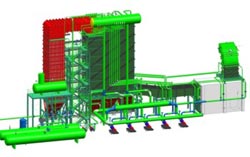Steam of hot flue gases saves energy at steel mills

<br>
In the past, flue gases were usually not utilized, so the energy they carried was lost. The system consists of steam boilers, pipes, water tanks, and pumps and can be directly integrated into the existing flue gas cooling system. Theoretically, the system could entirely replace conventional cooling.
A feasibility study carried out at a steel mill in Turkey revealed potential savings of 44.5 kilowatt hours of electricity per ton of steel produced. That corresponds to around ten percent of the electrical energy that is normally required. If the steam were used to preheat the feed water for the steel mill's power plant, for example, the mill would save 45,000 tons of coal per year.
Electric arc furnaces melt steel scrap under arcs heated to a temperature of about 3,500 °C using high-voltage electricity. Depending on the specific furnace operation, up to one third of the energy used escapes in the flue gases. Normally these flue gases – which can be as hot as 1,800 °C – are extracted from the furnace through water-cooled pipes. Because this cooling water circulates within a closed system, it cannot be permitted to form steam. Cooling towers dissipate the excess heat.
This is where the solution developed by the experts at Siemens Metals Technologies comes in. The hot flue gas is diverted into a steam generator, where it flows around pipes filled with water. The heat from the gas turns the water into steam. A sophisticated system of nested heating surfaces ensures that heat is transferred from the flue gas as efficiently as possible.
Special recirculation pumps ensure that the steam boiler is adequately cooled. The system can handle fluctuations in flue gas temperature and volume, and it is specially designed to deal with the high levels of dust, some of which is corrosive, in the flue gas. Continuous steam production, such as that required for generating electricity, can be achieved through the installation of optional storage buffers known as “steam accumulators.”
The heat from the flue gas can be recovered even more efficiently if the gas is directed through an “economizer” after it leaves the steam boiler. In the “economizer” the gas flows around a second system of pipes, where the remainder of its heat is used to preheat the feed water for the steam boiler.
The steam generation system has a modular construction and can be easily adapted to the specific requirements of each plant. This makes it especially easy to modernize existing steel mills.
Media Contact
More Information:
http://www.siemens.com/innovationnewsAll latest news from the category: Power and Electrical Engineering
This topic covers issues related to energy generation, conversion, transportation and consumption and how the industry is addressing the challenge of energy efficiency in general.
innovations-report provides in-depth and informative reports and articles on subjects ranging from wind energy, fuel cell technology, solar energy, geothermal energy, petroleum, gas, nuclear engineering, alternative energy and energy efficiency to fusion, hydrogen and superconductor technologies.
Newest articles

Silicon Carbide Innovation Alliance to drive industrial-scale semiconductor work
Known for its ability to withstand extreme environments and high voltages, silicon carbide (SiC) is a semiconducting material made up of silicon and carbon atoms arranged into crystals that is…

New SPECT/CT technique shows impressive biomarker identification
…offers increased access for prostate cancer patients. A novel SPECT/CT acquisition method can accurately detect radiopharmaceutical biodistribution in a convenient manner for prostate cancer patients, opening the door for more…

How 3D printers can give robots a soft touch
Soft skin coverings and touch sensors have emerged as a promising feature for robots that are both safer and more intuitive for human interaction, but they are expensive and difficult…





















